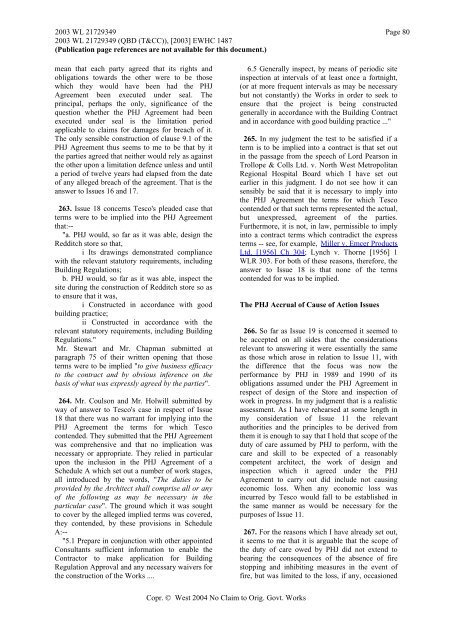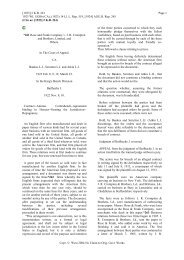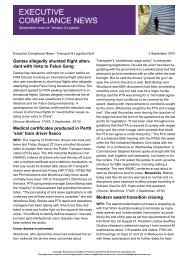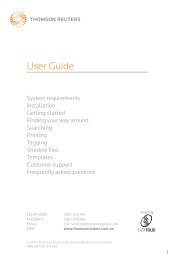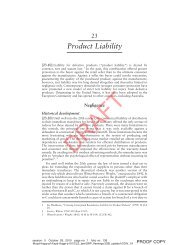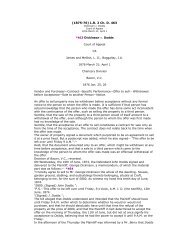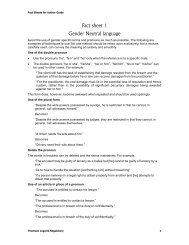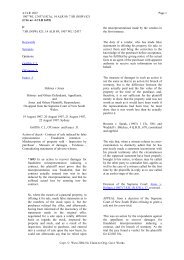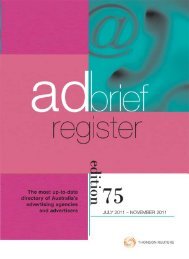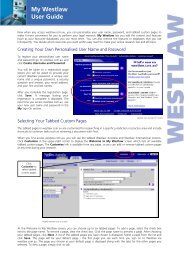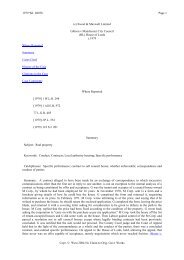Tesco v Constain - Thomson Reuters
Tesco v Constain - Thomson Reuters
Tesco v Constain - Thomson Reuters
You also want an ePaper? Increase the reach of your titles
YUMPU automatically turns print PDFs into web optimized ePapers that Google loves.
2003 WL 21729349 Page 802003 WL 21729349 (QBD (T&CC)), [2003] EWHC 1487(Publication page references are not available for this document.)mean that each party agreed that its rights andobligations towards the other were to be thosewhich they would have been had the PHJAgreement been executed under seal. Theprincipal, perhaps the only, significance of thequestion whether the PHJ Agreement had beenexecuted under seal is the limitation periodapplicable to claims for damages for breach of it.The only sensible construction of clause 9.1 of thePHJ Agreement thus seems to me to be that by itthe parties agreed that neither would rely as againstthe other upon a limitation defence unless and untila period of twelve years had elapsed from the dateof any alleged breach of the agreement. That is theanswer to Issues 16 and 17.263. Issue 18 concerns <strong>Tesco</strong>'s pleaded case thatterms were to be implied into the PHJ Agreementthat:--"a. PHJ would, so far as it was able, design theRedditch store so that,i Its drawings demonstrated compliancewith the relevant statutory requirements, includingBuilding Regulations;b. PHJ would, so far as it was able, inspect thesite during the construction of Redditch store so asto ensure that it was,i Constructed in accordance with goodbuilding practice;ii Constructed in accordance with therelevant statutory requirements, including BuildingRegulations."Mr. Stewart and Mr. Chapman submitted atparagraph 75 of their written opening that thoseterms were to be implied "to give business efficacyto the contract and by obvious inference on thebasis of what was expressly agreed by the parties".264. Mr. Coulson and Mr. Holwill submitted byway of answer to <strong>Tesco</strong>'s case in respect of Issue18 that there was no warrant for implying into thePHJ Agreement the terms for which <strong>Tesco</strong>contended. They submitted that the PHJ Agreementwas comprehensive and that no implication wasnecessary or appropriate. They relied in particularupon the inclusion in the PHJ Agreement of aSchedule A which set out a number of work stages,all introduced by the words, "The duties to beprovided by the Architect shall comprise all or anyof the following as may be necessary in theparticular case". The ground which it was soughtto cover by the alleged implied terms was covered,they contended, by these provisions in ScheduleA:--"5.1 Prepare in conjunction with other appointedConsultants sufficient information to enable theContractor to make application for BuildingRegulation Approval and any necessary waivers forthe construction of the Works ....6.5 Generally inspect, by means of periodic siteinspection at intervals of at least once a fortnight,(or at more frequent intervals as may be necessarybut not constantly) the Works in order to seek toensure that the project is being constructedgenerally in accordance with the Building Contractand in accordance with good building practice ..."265. In my judgment the test to be satisfied if aterm is to be implied into a contract is that set outin the passage from the speech of Lord Pearson inTrollope & Colls Ltd. v. North West MetropolitanRegional Hospital Board which I have set outearlier in this judgment. I do not see how it cansensibly be said that it is necessary to imply intothe PHJ Agreement the terms for which <strong>Tesco</strong>contended or that such terms represented the actual,but unexpressed, agreement of the parties.Furthermore, it is not, in law, permissible to implyinto a contract terms which contradict the expressterms -- see, for example, HMiller v. Emcer ProductsLtd. [1956] Ch 304; Lynch v. Thorne [1956] 1WLR 303. For both of these reasons, therefore, theanswer to Issue 18 is that none of the termscontended for was to be implied.The PHJ Accrual of Cause of Action Issues266. So far as Issue 19 is concerned it seemed tobe accepted on all sides that the considerationsrelevant to answering it were essentially the sameas those which arose in relation to Issue 11, withthe difference that the focus was now theperformance by PHJ in 1989 and 1990 of itsobligations assumed under the PHJ Agreement inrespect of design of the Store and inspection ofwork in progress. In my judgment that is a realisticassessment. As I have rehearsed at some length inmy consideration of Issue 11 the relevantauthorities and the principles to be derived fromthem it is enough to say that I hold that scope of theduty of care assumed by PHJ to perform, with thecare and skill to be expected of a reasonablycompetent architect, the work of design andinspection which it agreed under the PHJAgreement to carry out did include not causingeconomic loss. When any economic loss wasincurred by <strong>Tesco</strong> would fall to be established inthe same manner as would be necessary for thepurposes of Issue 11.267. For the reasons which I have already set out,it seems to me that it is arguable that the scope ofthe duty of care owed by PHJ did not extend tobearing the consequences of the absence of firestopping and inhibiting measures in the event offire, but was limited to the loss, if any, occasionedCopr. © West 2004 No Claim to Orig. Govt. Works


